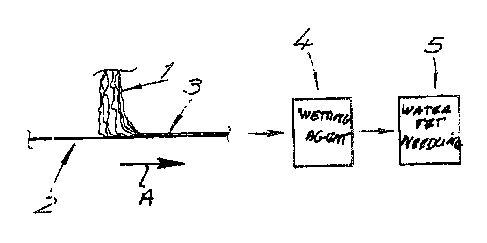Some of the information on this Web page has been provided by external sources. The Government of Canada is not responsible for the accuracy, reliability or currency of the information supplied by external sources. Users wishing to rely upon this information should consult directly with the source of the information. Content provided by external sources is not subject to official languages, privacy and accessibility requirements.
Any discrepancies in the text and image of the Claims and Abstract are due to differing posting times. Text of the Claims and Abstract are posted:
| (12) Patent: | (11) CA 2454124 |
|---|---|
| (54) English Title: | METHOD OF PRODUCING A NONWOVEN FABRIC FROM FILAMENTS |
| (54) French Title: | METHODE DE FABRICATION D'UN TISSU NON-TISSE A PARTIR DE FILAMENTS |
| Status: | Expired and beyond the Period of Reversal |
| (51) International Patent Classification (IPC): |
|
|---|---|
| (72) Inventors : |
|
| (73) Owners : |
|
| (71) Applicants : |
|
| (74) Agent: | BORDEN LADNER GERVAIS LLP |
| (74) Associate agent: | |
| (45) Issued: | 2006-07-25 |
| (22) Filed Date: | 2003-12-23 |
| (41) Open to Public Inspection: | 2004-08-10 |
| Examination requested: | 2004-03-23 |
| Availability of licence: | N/A |
| Dedicated to the Public: | N/A |
| (25) Language of filing: | English |
| Patent Cooperation Treaty (PCT): | No |
|---|
| (30) Application Priority Data: | ||||||
|---|---|---|---|---|---|---|
|
Spun bond is made by collecting thermoplastic filaments on a perforated surface and the spun bon is then subjected to hydrodynamic consolidation with high-pressure water jets. The filaments before the formation of the spun bond or after the formation of the spun bond are treated with a wetting agent prior to the hydrodynamic consolidation.
Du filé-lié est obtenu en recueillant des filaments thermoplastiques sur une surface perforée et le filé-lié est alors soumis à une consolidation hydrodynamique avec jets d'eau sous haute pression. Les filaments avant la formation du filé-lié ou après la formation du filé-lié sont traités avec un agent mouillant avant la consolidation hydrodynamique.
Note: Claims are shown in the official language in which they were submitted.
Note: Descriptions are shown in the official language in which they were submitted.

2024-08-01:As part of the Next Generation Patents (NGP) transition, the Canadian Patents Database (CPD) now contains a more detailed Event History, which replicates the Event Log of our new back-office solution.
Please note that "Inactive:" events refers to events no longer in use in our new back-office solution.
For a clearer understanding of the status of the application/patent presented on this page, the site Disclaimer , as well as the definitions for Patent , Event History , Maintenance Fee and Payment History should be consulted.
| Description | Date |
|---|---|
| Time Limit for Reversal Expired | 2023-06-23 |
| Letter Sent | 2022-12-23 |
| Letter Sent | 2022-06-23 |
| Letter Sent | 2021-12-23 |
| Common Representative Appointed | 2019-10-30 |
| Common Representative Appointed | 2019-10-30 |
| Inactive: IPC deactivated | 2013-11-12 |
| Inactive: IPC deactivated | 2013-11-12 |
| Inactive: IPC removed | 2013-02-27 |
| Inactive: First IPC assigned | 2013-02-27 |
| Inactive: IPC assigned | 2013-02-27 |
| Inactive: IPC assigned | 2013-02-27 |
| Inactive: IPC removed | 2013-02-27 |
| Inactive: IPC expired | 2012-01-01 |
| Inactive: IPC expired | 2012-01-01 |
| Inactive: Late MF processed | 2010-12-29 |
| Letter Sent | 2010-12-23 |
| Grant by Issuance | 2006-07-25 |
| Inactive: Cover page published | 2006-07-24 |
| Pre-grant | 2006-05-15 |
| Inactive: Final fee received | 2006-05-15 |
| Inactive: IPC from MCD | 2006-03-12 |
| Inactive: IPC from MCD | 2006-03-12 |
| Inactive: IPC from MCD | 2006-03-12 |
| Notice of Allowance is Issued | 2006-02-24 |
| Letter Sent | 2006-02-24 |
| Notice of Allowance is Issued | 2006-02-24 |
| Inactive: Approved for allowance (AFA) | 2006-01-23 |
| Amendment Received - Voluntary Amendment | 2004-11-01 |
| Application Published (Open to Public Inspection) | 2004-08-10 |
| Inactive: Cover page published | 2004-08-09 |
| Inactive: Correspondence - Formalities | 2004-04-26 |
| Letter Sent | 2004-04-07 |
| Inactive: IPC removed | 2004-03-31 |
| Inactive: First IPC assigned | 2004-03-31 |
| Request for Examination Received | 2004-03-23 |
| Request for Examination Requirements Determined Compliant | 2004-03-23 |
| All Requirements for Examination Determined Compliant | 2004-03-23 |
| Letter Sent | 2004-03-19 |
| Inactive: Single transfer | 2004-03-01 |
| Inactive: First IPC assigned | 2004-02-29 |
| Inactive: Filing certificate - No RFE (English) | 2004-02-12 |
| Filing Requirements Determined Compliant | 2004-02-12 |
| Application Received - Regular National | 2004-02-12 |
There is no abandonment history.
The last payment was received on 2005-11-21
Note : If the full payment has not been received on or before the date indicated, a further fee may be required which may be one of the following
Please refer to the CIPO Patent Fees web page to see all current fee amounts.
Note: Records showing the ownership history in alphabetical order.
| Current Owners on Record |
|---|
| REIFENHAEUSER GMBH & CO. MASCHINENFABRIK |
| Past Owners on Record |
|---|
| JENS GUEDDEN |
| SEBASTIAN SOMMER |